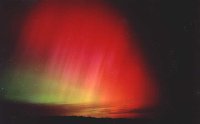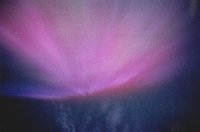The aurora borealis, a cosmic phenomenon resulting from the interplay
between sun and earth, is well known since antique times. An aurora is
caused by corpuscular rays coming from the sun, which are deviated in
the magnetic field of the earth towards the poles and which stimulate
the molecules of the air to gleam. They are usually observed at altitudes
between 65 and 400 km, but during magnetic storms they can reach up to
1200 km.
Even in our medium latitudes auroras have only been observed by chance. So
it is known only approximately how often they appear. At lower geographic
latitudes the probability to see an aurora becomes smaller. Furthermore,
solar activity plays an important role. During maximum solar activity
(e.g. in 1957), a lot of auroras were observed. But also near a minimum
there may be eruptions on the sun which can cause major geomagnetic perturbations,
so that auroras can also become visible in medium latitudes. The rule
of thumb is that during maximum solar activity there are between 4 and
8 auroras a year visible from Germany. But there can also be sporadic
auroras visible around the minimum.
Observing an aurora is relatively easy because contrary to other phenomena
in the sky (noctilucent clouds, increased airglow, milky way, etc.), it
is active: There are lots of shapes that change, sometimes a whitish arc
above the horizon, sometimes rays shooting up, sometimes isolated planes
or spots that can have different colours. At our latitudes they are in
most cases reddish, but during heavy geomagnetic perturbations, also other
colours can appear, for example an intense violet.
Auroras often appear after remarkable solar eruptions, about 24 to 36
hours after the solar event. That is the time the particles need to reach
the earth, cause geomagnetic perturbations and stimulate the gleam in
the upper atmosphere. As a consequence of the geomagnetic perturbation
the aurora zone moves towards the equator and the phenomena can also be
observed at medium latitudes. On our
aurora prediction
page you can inform about the current activity and forecasts.
If an aurora appears, you should keep an eye on changes in its shape (planes,
spots, colours and how they change). Other desirable data are date, place
of observation (coordinates), hour (UTC), beginning and end of observation,
state of the sky, description of the aurora (arcs, planes, rays, colours,
changes). For this we have a form. A photographic documentation would
also be important. This could be easily made with almost all cameras available
(when they allow a long, manually controlled time of exposure) and sensible
films at different times of exposure (the best would be if you made a
series of pictures using different times of exposure).
© AKM e.V.

